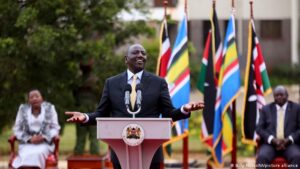The Babukusu are the major sub tribe of the Luhya tribe in Kenya. They have one of the highest population as compared to other sub tribes and also occupy the largest part of the western part. This part of the country is where the majority of Luhyas are situated and is generally associated with their kind. Apart from the Babukusu, other sub tribes include; Tachoni, Kabras, Tsotso, Tiriki, Isukha, Idakho, Marama, Banyala, Maragoli, Manyore, Kisa, Wanga, Marachi, Samia, Khayo, and the Manyala. The sub tribes are approximately eighteen with similarities in their speech pronunciation and culture.

Initially, the Bukusus were called the Babambayi. This term generally means that they were farmers and pastoralists, though in small scale. Before they moved into the western part of Kenya, the Bukusus used to sell hoes in central Uganda.
The name Bukusu therefore, is derived from a term UKUSI, which means the price. In their general daily economic activities, they always encountered the term UKUSI as in the sentence. An example of this could be during negotiation where they would ask, “What is the price (UKUSI) of this hoe?”. The buyers then ended up branding them as BUKUSU in consideration of the word UKUSI.
Bukusus are broadly categorized into clans known as Chikholo. Intermarriage within people of the similar clan is prohibited hence regarded as an abomination. The clans are fifteen, namely; Bakibeti, Batilu, Bameme, Baloncha, Bayundo, Babichachi, Baengele, Batukuika, Batecho, Bachemai, Bakoi, Basekese, Balunda and the Basefu.
The cultures of the clans might differ a little in details such as culture and various rites of passage. For instance, the Balunda burry the dead in a sitting posture, while Baengele undergo a ritual known as Buliche after circumcision.
The Bukusu Age Sets and Age Groups
The circumcision ritual among the Bukusus leads to the development of age sets known as Bibilingo. These age sets include; Sawa, Kolongolo, Kikwamet, Bakananachi, Kinyikeu, Nyange, Maina, and Chuma.
The age sets form a cyclist system, with each age group having a gap of ten years within each other. This is with the exclusion of Bachuma, which lasted for fourteen years. The reason for this was the belief that there was an old man of the age group of Basawa, who was still alive and was not meant to live and see the next Basawa.
Eventually, the old man died in 1884 and the Basawa ensued the next initiation period in 1888. It was therefore agreed to avoid such delays and that any man who lives long enough to reach the second cycle would be killed. This has been the tradition and since then, once the last age group has passed the second one starts. For exampl,e the Bachuma lasted from 1872 to 1886. In 1888, the Basawa age group began and lasted until 1898. Each age group is represented once every century.












1 thought on “Origin of The Bukusu Name and Traditions”